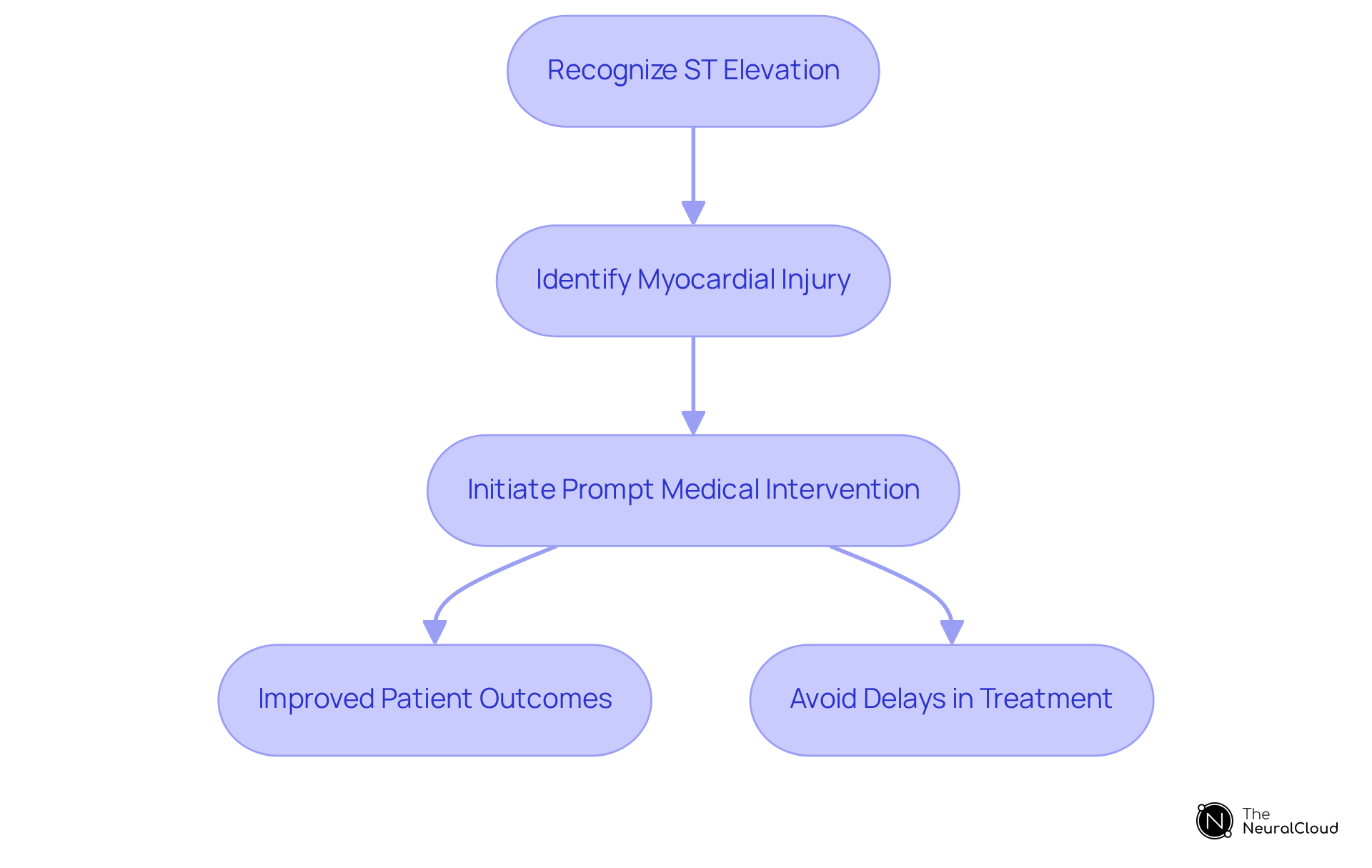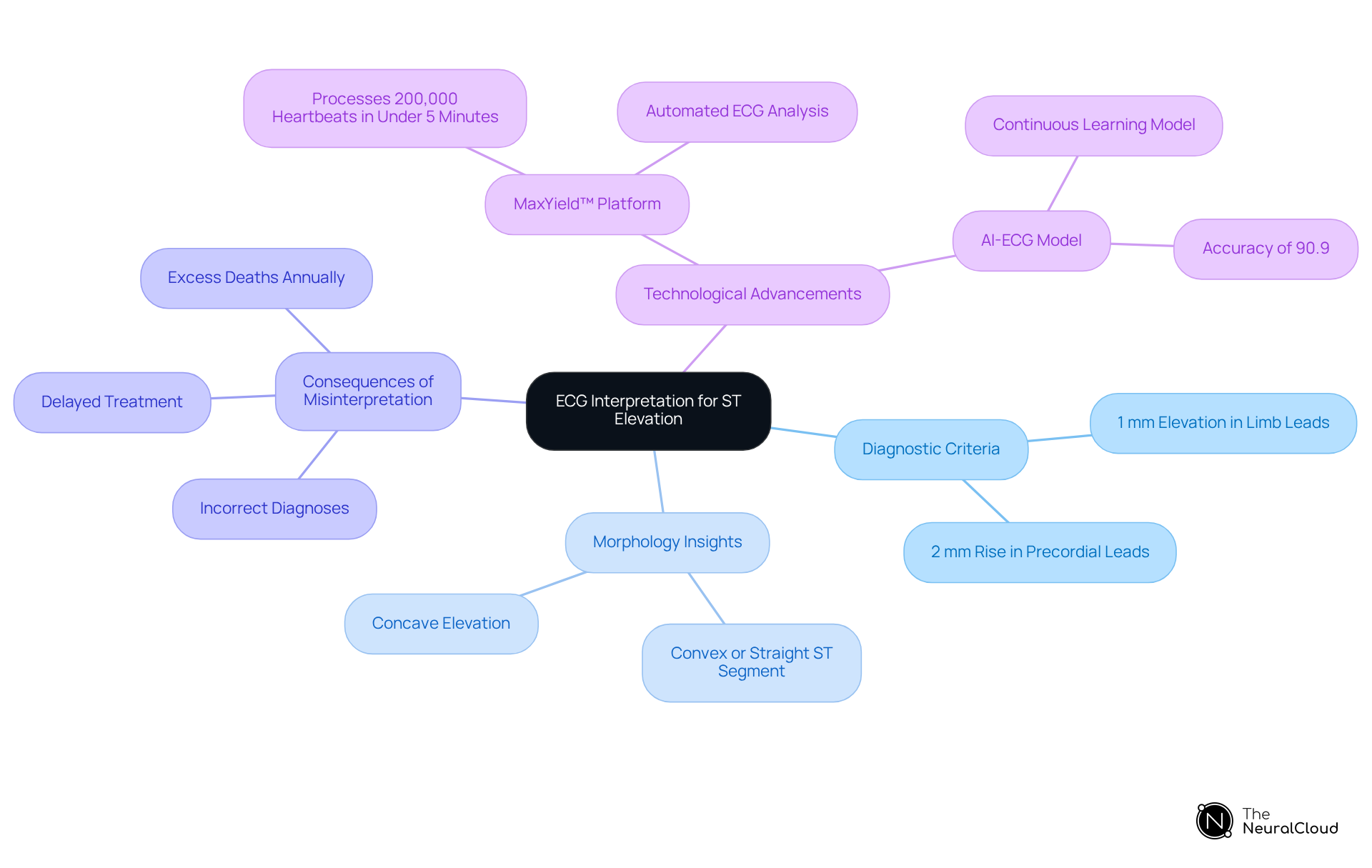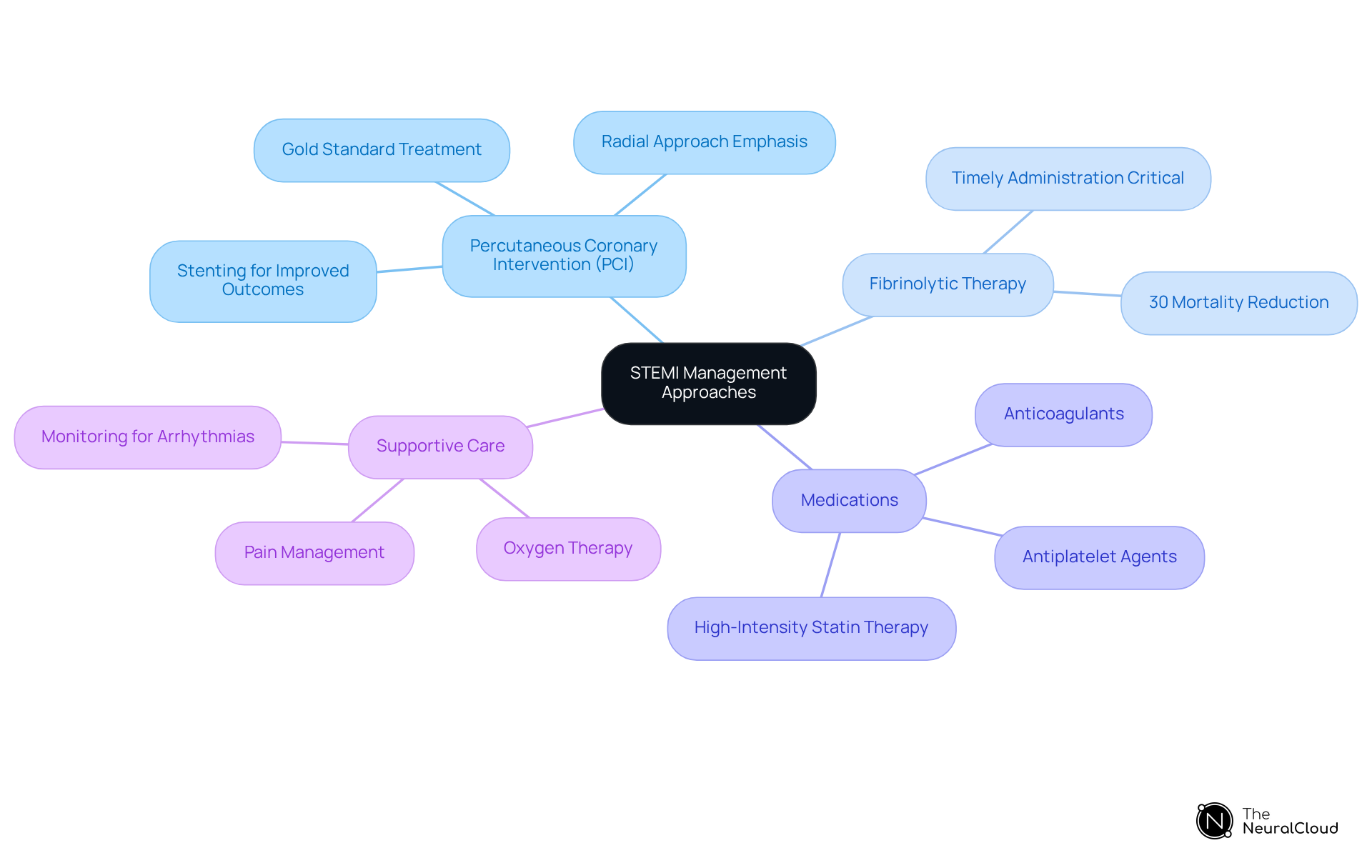Overview
ST elevation on an electrocardiogram (ECG) signifies potential myocardial injury and is frequently associated with ST elevation Myocardial Infarction (STEMI). This condition necessitates immediate medical intervention to enhance patient outcomes. Recognizing ST elevation is essential for timely diagnosis and treatment, as any delays can result in significant morbidity and mortality. Therefore, accurate ECG interpretation is crucial. Additionally, the integration of advanced diagnostic technologies further underscores the importance of effective ECG analysis.
Introduction
Understanding the nuances of ST elevation on an electrocardiogram (ECG) is essential for healthcare professionals, as it serves as a critical indicator of myocardial injury or ischemia. This article explores the clinical significance of ST elevation, providing insights into its physiological mechanisms, diagnostic criteria, and management strategies for ST elevation myocardial infarction (STEMI). The challenge remains: how can practitioners ensure timely recognition and intervention to enhance patient outcomes amidst potential diagnostic pitfalls?
Define ST Elevation and Its Clinical Importance
An unusual increase of the ST segment on an electrocardiogram (ECG), known as ST elevation, signifies potential myocardial injury or ischemia. Clinically, this rise is most frequently linked to [ST elevation Myocardial Infarction](https://theneuralcloud.com/post/7-key-st-elevation-myocardial-infarction-criteria-for-accurate-diagnosis) (STEMI), a serious condition that demands prompt medical attention. The rise occurs when the J point is positioned above the baseline, indicating that the heart muscle is not receiving sufficient blood supply. Identifying ST elevation is crucial for healthcare workers, as it can lead to prompt actions that greatly enhance outcomes during acute coronary incidents.
Delays in diagnosis and inefficient triage can prevent timely treatment for heart attack patients. Studies indicate that only 17% of patients at rural centers reach the catheterization lab in time for intervention. Additionally, findings from the FAST-MI programme emphasize that six-month mortality rates following ST elevation myocardial infarction are a significant concern. As Stephen Smith, MD, pointed out, the focus should not solely be on ST changes but rather on acute coronary blockage, which results in imminent myocardial necrosis or death.
This underscores the urgency of and the need for prompt medical intervention. By understanding the implications of ST elevation, healthcare professionals can better navigate the complexities of ECG analysis, ultimately enhancing patient care and outcomes.

Explain the Physiology of ST Elevation in Myocardial Infarction
The rise in ST elevation during myocardial infarction primarily results from ischemia, which occurs when the blood supply to the heart muscle is compromised. Ischemic myocardial cells display abnormal repolarization, resulting in a net positive deflection in the ST elevation segment on the ECG. This phenomenon is largely due to the accumulation of extracellular potassium and the , which is essential for maintaining normal electrical activity. The ST elevation indicates that the affected myocardial tissue is undergoing necrosis, and the presence of ST elevation in adjacent leads is crucial for identifying the infarction region, thereby guiding further management decisions.
Real-world examples illustrate that a significant proportion of individuals exhibiting ST elevation are indeed experiencing ischemia, highlighting the importance of rapid diagnosis. Establishing a heart attack diagnosis within 20 minutes is critical, as it correlates with faster treatment times and improved outcomes for patients. Expert opinions stress that understanding the physiological basis of ST elevation is essential for clinicians, as it directly influences treatment strategies and patient outcomes. Furthermore, AI technologies are revolutionizing heart attack diagnosis by enhancing ECG interpretation, which can minimize human error and increase diagnostic accuracy.
Grasping these mechanisms not only facilitates accurate diagnosis but also improves the effectiveness of interventions aimed at restoring blood flow and reducing myocardial damage. It is also vital for clinicians to identify conditions that may mimic a heart attack on an ECG, as misinterpretation can lead to unnecessary interventions. Notably, between 2.5% and 10% of individuals who suffer a heart attack may die within 30 days, highlighting the critical importance of prompt intervention.

Outline ECG Interpretation and Diagnostic Criteria for ST Elevation
To diagnose [ST segment rise myocardial infarction](https://theneuralcloud.com/post/master-sinus-rhythm-ecg-interpretation-with-step-by-step-guidance) (STEMI), specific must be fulfilled according to the American College of Cardiology/American Heart Association (ACC/AHA) guidelines. ST elevation is characterized by:
- A minimum of 1 mm of elevation in two or more contiguous limb leads, and
- At least 2 mm of rise in two or more adjacent precordial leads (V1-V6).
The morphology of the ST segment also provides critical diagnostic insights. A convex or straight ST segment is usually indicative of a myocardial infarction, whereas a concave elevation may suggest alternative conditions. Accurate interpretation of these criteria is essential, as misinterpretation can lead to incorrect diagnoses and delayed treatment, contributing to the approximately 10,000 excess deaths annually in the U.S. related to erroneous ECG interpretations. Research indicates that 8% of individuals diagnosed with ST elevation myocardial infarction initially exhibit nondiagnostic ECGs, highlighting the necessity for attentiveness in evaluating ST elevation on ECG.
Prompt identification and suitable care, such as reperfusion therapy, are essential for enhancing patient results in acute myocardial infarction situations. The AI-ECG model has shown a 90.9% accuracy in detecting occlusion myocardial infarction, surpassing traditional criteria, which had an accuracy of 83.6%. The integration of advanced technologies like the MaxYield™ platform, which employs a continuous learning model, further enhances diagnostic accuracy and efficiency in ECG analysis. This platform not only improves the precision of diagnoses but also streamlines the process for healthcare professionals, ultimately benefiting patient care.

Detail Management Approaches for ST Elevation Myocardial Infarction
Management of ST elevation focuses on rapid reperfusion in ST elevation myocardial infarction (STEMI) to restore blood flow to the affected myocardium, significantly reducing morbidity and mortality. The primary treatment options include:
- Percutaneous Coronary Intervention (PCI): This is the gold standard for individuals presenting within 12 hours of symptom onset. PCI involves catheterization to open blocked coronary arteries, often accompanied by stenting, which enhances blood flow and improves outcomes for individuals. Recent guidelines emphasize the radial approach for PCI to minimize bleeding risks and vascular complications.
- Fibrinolytic Therapy: When PCI is not feasible within the recommended time frame, fibrinolytics can be administered to dissolve the thrombus obstructing blood flow. This therapy is most effective when given within the first few hours of symptom onset, underscoring the importance of timely intervention. Studies indicate that fibrinolytic therapy can reduce mortality rates by approximately 30% when administered promptly.
- Medications: In conjunction with reperfusion strategies, individuals should receive antiplatelet agents (such as aspirin and clopidogrel), anticoagulants, and beta-blockers to manage symptoms and prevent further complications. High-intensity statin therapy is also advised for all individuals with acute coronary syndromes (ACS), as it plays a crucial role in enhancing long-term outcomes.
- Supportive Care: Essential components of care during the acute phase include oxygen therapy, pain management, and vigilant monitoring for arrhythmias. These measures are critical to stabilize the patient and facilitate recovery.
Timely and effective management of STEMI is crucial, as can significantly improve survival rates. Identifying ST elevation on ECG is crucial for commencing these life-saving treatments, making advanced ECG analysis tools such as Neural Cloud Solutions' MaxYield™ platform essential in clinical environments. The MaxYield™ platform automates the labeling of ECG waveforms, enhancing workflow efficiency and enabling healthcare professionals to quickly identify ST elevation, thus facilitating prompt treatment decisions. As noted by Jacqueline Tamis-Holland, MD, FSCAI, the integration of such advanced technologies is essential for adhering to the latest guidelines and improving patient outcomes.

Conclusion
Recognizing and understanding ST elevation on an electrocardiogram (ECG) is vital for timely diagnosis and effective management of myocardial infarction, particularly ST elevation myocardial infarction (STEMI). This increase in the ST segment serves as a critical indicator of heart muscle ischemia, emphasizing the need for healthcare professionals to act swiftly to improve patient outcomes. The implications of ST elevation extend beyond mere interpretation; they represent a call to action in emergency care settings where every minute matters.
Key insights have highlighted the physiological mechanisms behind ST elevation, the importance of accurate ECG interpretation, and the management strategies that can save lives. Recognizing ST elevation criteria and employing advanced technologies for improved diagnostic accuracy underscore the intricate relationship between timely intervention and patient survival. Additionally, the role of innovative platforms like MaxYield™ showcases how integrating technology can enhance clinical workflows and ultimately benefit patient care.
In light of these insights, it is imperative for medical professionals to prioritize the swift recognition and management of ST elevation. By staying informed about the latest guidelines and leveraging advanced diagnostic tools, healthcare providers can significantly reduce morbidity and mortality associated with myocardial infarction. The urgency of addressing ST elevation cannot be overstated, as it serves not only as a critical diagnostic marker but also as a lifeline for patients at risk of severe cardiac events.
Frequently Asked Questions
What is ST elevation?
ST elevation is an unusual increase of the ST segment on an electrocardiogram (ECG), indicating potential myocardial injury or ischemia.
What condition is most commonly associated with ST elevation?
ST elevation is most frequently linked to ST elevation Myocardial Infarction (STEMI), a serious condition that requires prompt medical attention.
What does the presence of ST elevation indicate about blood supply to the heart?
The presence of ST elevation indicates that the heart muscle is not receiving sufficient blood supply, as the J point is positioned above the baseline.
Why is identifying ST elevation important for healthcare workers?
Identifying ST elevation is crucial for healthcare workers because it can lead to timely actions that greatly enhance outcomes during acute coronary incidents.
What are the consequences of delays in diagnosing ST elevation?
Delays in diagnosis and inefficient triage can prevent timely treatment for heart attack patients, leading to poor outcomes.
What percentage of patients at rural centers reach the catheterization lab in time for intervention?
Studies indicate that only 17% of patients at rural centers reach the catheterization lab in time for intervention.
What do findings from the FAST-MI programme reveal about mortality rates after ST elevation myocardial infarction?
Findings from the FAST-MI programme emphasize that six-month mortality rates following ST elevation myocardial infarction are a significant concern.
What should healthcare professionals focus on regarding ST elevation?
Healthcare professionals should focus not solely on ST changes but rather on acute coronary blockage, which can lead to imminent myocardial necrosis or death.
How can understanding ST elevation improve patient care?
By understanding the implications of ST elevation, healthcare professionals can better navigate the complexities of ECG analysis, ultimately enhancing patient care and outcomes.






